Episodes
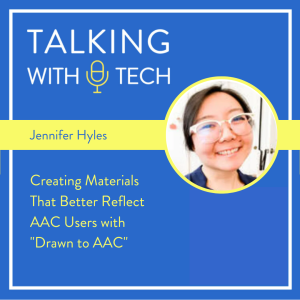
Friday Feb 03, 2023
Friday Feb 03, 2023
This week, Rachel interviews the artist behind the Instagram account @drawntoaac, Jennifer Hyles! Along with being an amazing artist, Jennifer is also an SLP who specializes in supporting AAC users! Jennifer and Rachel talk all about Jennifer’s journey getting started creating Drawn to AAC, why Jennifer was motivated to create clip art that depicts diverse AAC users in a variety of settings, and more!
Before the interview, Chris and Rachel discuss using our client/student’s highly specific interests to create more motivating activities and materials. Rachel shares about one of her clients who is very interested in ceiling fans, and all the ways that she has effectively incorporated ceiling fans into that client’s therapy! They also talk about moving clients beyond those restrictive interests by exposing them gradually to new things that may be of interest (e.g. clips of a new show they haven’t seen before).
Key ideas this week:
🔑 Drawn to AAC’s art is a great way to incorporate images of AAC users from different cultures and backgrounds into our own therapy. Being able to depict a diverse array of AAC users allows therapists and practitioners to better reflect the users themselves when we create materials.
🔑 Based on feedback that Jennifer has received from SLPs and others, she has created art that was designed to be less cartoonish and more age-respectful for middle and high school students.
🔑 One benefit of working with Jennifer’s art is she is an SLP who understands AAC assessment and implementation. Her free resources are based on better AAC practices, and, if you ever decide that you want to commission some art from her related to AAC, she doesn’t need a lot of extra information to understand exactly what you need.
Links from this week’s episode:
Drawn to AAC on Instagram
Drawn to AAC on TPT and Ko-Fi
Visit talkingwithtech.org to access previous episodes, resources, and CEU credits that you can earn for listening to TWT episodes!
Help us develop new content and keep the podcast going strong! Support our podcast at patreon.com/talkingwithtech!
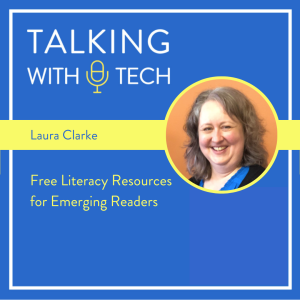
Wednesday Jan 25, 2023
Wednesday Jan 25, 2023
This week, Rachel interviews Dr. Laura Clarke, a special educator, teacher, and parent of a person with complex communication needs. Dr. Clarke who has created her own free website, Reading & Writing 4 All, that provides a variety of free resources to support literacy for emerging readers. Dr. Clarke shares about her journey as the parent of Dan, an emerging reader, and why she was motivated to provide literacy resources to special education teachers and parents of emerging readers.
Before the interview, Chris and Rachel discuss ChatGPT (chat.openai.com), a free chat artificial intelligence that can create some of the most human-like responses to questions ever. They ask the ChatGPT some AAC related questions, and Chris notes some of the national discussion about students using ChatGPT to do their homework for them. Chris points out that we should probably be figuring out how to help students use AI rather than trying to ban it, since these kinds of AI resources are probably not going away.
Key ideas this week:
🔑 Relationships and connection are essential to supporting emerging readers. Before we start coming up with content, we should have a knowledge of who the emerging reader is as a person and where their interests lie. This can lead to creating higher-interest content that is more engaging!
🔑 It is common to want emerging readers to show us they understand what we are showing them and that they are paying attention by asking them lots of "wh-" questions, etc. This can unknowingly put a lot of demands on our students and take away from our connection with them.
🔑 For emerging readers that may not want to look at text, find something they really love and put a picture of that thing on one side of a screen (e.g. a picture of Mario) and on the other side, you can put the text you want them to look at. Then, over time, you can make the picture of the preferred item smaller and smaller.
Links from this weeks episode:
Dr. Laura Clarke’s free website Reading & Writing 4 All: https://sites.google.com/view/emergingreaders/home
Northern Kentucky Cooperative for Educational Resources has over 100 free online professional learning modules at https://sites.google.com/nkces.org/nkces-online-trainings/home
You can reach Dr. Clarke by email at emergingreaderresources@gmail.com
Visit talkingwithtech.org to access previous episodes, resources, and CEU credits that you can earn for listening to TWT episodes!
Help us develop new content and keep the podcast going strong! Support our podcast at patreon.com/talkingwithtech!
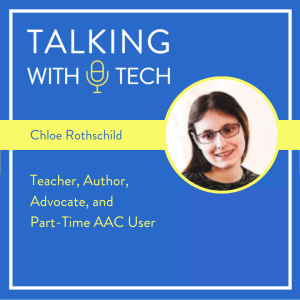
Wednesday Jan 18, 2023
Wednesday Jan 18, 2023
This week, Rachel interviews Chloe Rothschild, an autistic advocate, author, teacher, and speaker who uses AAC to communicate part-time. Chloe currently serves on the Board of Directors for The Arc, a disability advocacy group, as well as working with the Ohio Center for Autism and Low Incidence. Chloe joins the podcast to share her amazing insights into using different communication modalities depending upon the demands of the situation, as well as a discussion of using her Apple Watch for AAC, working with nonspeaking children in an autistic classroom, why she like to use symbols to communicate even though she is a fast typer, and more!
Key ideas this week:
🔑 There are many reasons why someone may not speak in some situations, such as their anxiety level or the demands of the situation. We should not assume that every person who uses verbal speech can use it all the time.
🔑 Chloe uses pre-programmed “quick fire” messages via Proloquo4Text on her Apple Watch to communicate in some situations, such as when she needs a break out in the community.
🔑 Chloe prefers to use her symbol-based AAC system, Proloquo2Go, instead of her text-based AAC system, Proloquo4Text. Chloe says she “thinks in pictures”, so when she looks at her grid of symbols, she instantly knows what the symbols mean. When there are no symbols, she has to read every word every time, which her takes longer.
Links:
Chloe’s website: chloerothschildasd.com
My Interception Workbook: A Guide for Teens, Adolescents, and Adults by Kelly Mahler, Chloe Rothschild, and Jarvis Alma.
Chloe is a Board Member of The Arc for People with Intellectual and Developmental Disabilities: thearc.org
Visit talkingwithtech.org to access previous episodes, resources, and CEU credits that you can earn for listening to TWT episodes!
Help us develop new content and keep the podcast going strong! Support our podcast at patreon.com/talkingwithtech!
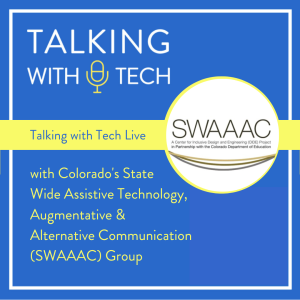
Wednesday Jan 11, 2023
Wednesday Jan 11, 2023
This week, Chris and Rachel host a lively session of Talking with Tech Live with members of Colorado’s State Wide Assistive Technology, Augmentative & Alternative Communication (SWAAAC) group! SWAAAC teams are interdisciplinary groups (e.g. SLPs, OTs, PTs) that provide Assistive Technology services in Colorado schools. As with previous episodes of Talking with Tech Live, Chris and Rachel facilitated a collaborative discussion with the audience based on questions submitted by the audience.
Key questions this week include:
❓How do we keep up with AAC software and the features that are coming out?
❓What should we do if the AAC Specialist in our district is using the candidacy model and doesn’t believe that a student is “ready” for a robust language system?
❓What is the best way to help educators embrace a functional communication system in a classroom?
❓How can we convince SLPs and Behavior Interventionists we work with that a student needs a robust vocabulary and not just a few nouns for requesting?
❓What is the best way to support English Language Learners who use AAC when we don’t speak their primary language?
Visit talkingwithtech.org to access previous episodes, resources, and CEU credits that you can earn for listening to TWT episodes!
Help us develop new content and keep the podcast going strong! Support our podcast at patreon.com/talkingwithtech!
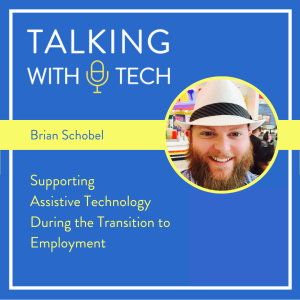
Wednesday Jan 04, 2023
Wednesday Jan 04, 2023
This week, we present Chris’s interview with Brian Schobel, a District Resource Teacher for Transition in Albuquerque, NM. Brian has worked for years supporting transition and employment for people with special needs. Brian reached out to interview Chris about inclusion and how technology can help students of different abilities gain meaningful employment. During the interview, Brian and Chris discuss assistive technology tools that can be used to support students as they transition to employment, as well as areas where we can improve in our support. Brian also shares about using Read & Write by TextHelp himself at work, and why being an assistive technology user inspires Brian to support others who use assistive technology.
Before the interview, Rachel and Chris have an actual in-person banter session at an airport in Minnesota! Rachel and Chris were recently presenting at the PATINS Access to Education conference in Indiana, and they jumped at the opportunity to record a podcast banter while waiting for their next flight. Rachel had two presentations at the PATINS conference. The first presentation was with Elisa Wern and covered using screen recording tools to support students. Elisa compared the tools Screencastify, Screencast-o-matic , and Loom, while Rachel discussed how she uses screen recording for asynchronous learning and coaching. Rachel’s second presentation was about on taking a team-based approach to AAC assessment through an abbreviated version of her AAC Ally course (https://rachelmadelslp.thinkific.com/courses/AAC-ally). Chris presented four time at PATINS, including presentations on inclusive coding for robots, ways to enhance AAC implementation, and combining core words with morphemes (e.g. “corephemes”). Chris also did a Wonderfully Inclusive Scavenger Hunt and ran a session where they played Cards against Exclusivity at the conference.
Key ideas this week:
🔑 Locking students into a particular browser for testing that doesn’t allow extensions related to assistive technology can be a significant issue. Even if we include voice to text and text to voice software on the test, if it isn’t the same buttons and voices that the student is used to, which can put them at a disadvantage.
🔑 You can provide both a traditional and more accessible option when assigning work in the classroom. For example, you can give a traditional paper-and-pencil worksheet to some students while also providing a digital copy to students who need it for text-to-speech. Even better, you can avoid giving a worksheet at all and provide something more interesting and meaningful while also being inclusive.
🔑 Saying “laptops closed and phones away” in a classroom can be ableist, because not everyone who is using technology is using it as a distraction. Everyone loses attention at times, even if you are looking at someone, your mind can wander. We want to give students the chance to make mistakes and to deal with distractions appropriately rather than taking all technology away from them.
🔑 How can we help places of employment adopt the same inclusive tools we are encouraging in the classroom? Companies are becoming more flexible with working remotely - we should help companies see the benefits of also being flexible supporting technological accommodations.
Visit talkingwithtech.org to access previous episodes, resources, and CEU credits that you can earn for listening to TWT episodes!
Help us develop new content and keep the podcast going strong! Support our podcast at patreon.com/talkingwithtech!
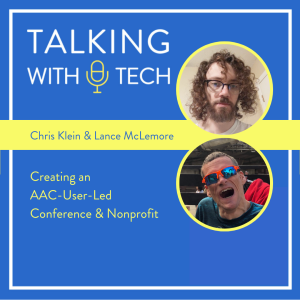
Wednesday Dec 14, 2022
Wednesday Dec 14, 2022
This week, Chris and Rachel have asked the amazing Chris Klein and Lance McLemore to “take over” the Talking with Tech podcast! Chris and Lance are experienced AAC users and board members of the nonprofit, ImpAACt Voices (https://www.impaactvoices.org/). Lance and Chris share some of the goals and objectives for ImpAACt Voices, and also relate some of their takeaways from the recent First Annual ImpAACt Voices conference, which focused on helping adult AAC users finding employment and educating the business world at large about AAC!
Key ideas this week:
🔑 ImpAACt Voices helps combat social isolation by doing virtual hangouts with AAC users of different skills and abilities across the country. Lance didn’t meet another AAC user until he was an adult - Lance and Chris want to help to help other AAC Users connect at a younger age.
🔑 ImpAACt Voices is creating a program, ImpAACtful Hiring, that aims to help achieve AAC Users gain meaningful employment. Over the next 3-5 years, ImpAACtful Hiring plans to partner with businesses for provide paid internship opportunities for AAC Users!
🔑 The unemployment rate for AAC users is very high, and at their recent conference, the ImpAACt Voices team focused on helping adult AAC users find employment to help meet this important need. Lance and Chris both believe that employment is critical to how we feel about ourselves, and too often, employment is an afterthought for AAC users.
To donate to ImpAACt Voices for free (with purchase) via Amazon Smile, go to https://smile.amazon.com/ch/85-3947506
Visit talkingwithtech.org to access previous episodes, resources, and CEU credits that you can earn for listening to TWT episodes!
Help us develop new content and keep the podcast going strong! Support our podcast at patreon.com/talkingwithtech!
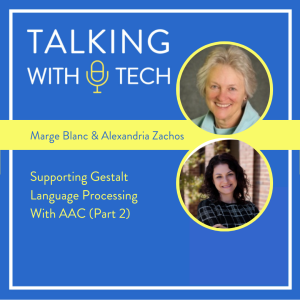
Thursday Dec 08, 2022
Thursday Dec 08, 2022
This week, we present Part 2 of Chris and Rachel's interview with Marge Blanc and Alexandria Zachos, two SLPs who have written and presented about the Natural Language Acquisition framework (NLA) and Gestalt Language Processing. The NLA framework looks at the different ways that people, especially people with autism, develop language. One important aspect of this is “gestalts”which are strings of language that can be long or short, and are often tied to an emotional, meaningful, or dramatic experience. This portion of the interview focuses on Stage 2, 3, and 4 of the NLA framework and how these stages can inform our practices with AAC. To learn more about Stage 1, listen to Part 1 of this episode here.
Before the interview, Chris and Rachel discuss a listener question about putting “too many” symbols on a device versus not having enough symbols on the grid. They also discuss the reaction from some teachers when a student is “playing” with a device, and why it’s not a realistic expectation for a child learning language to completely avoid exploring and playing with their device.
Key ideas this week:
🔑 Stage 2 of the Natural Language Acquisition (NLA) framework is “Mitigated Gestalts”, where the person takes a chunk from one gestalt and a chunk from another gestalt and puts them together. They might also trim down a gestalt to be shorter, for example reducing “Don’t worry, I’ll help you find your Mama” to “Don’t worry”.
🔑 Stage 3 of the NLA framework, “Isolation of the Single Word,” a person who is gestalt language processing is able to recognize words as units and pull the words out of their slots. They also become referential and will begin to reference or point to things.
🔑 According to Marge, there is an impulse when a student gets to Stage Three of the NLA framework to jump to teaching all different kinds of grammar, but at this stage it’s really more about combining words together. If we go too fast and jump ahead, the student may gain splinter skills while failing to develop the foundational skills necessary to move to Stage 4.
🔑 Stage 4 of the NLA framework is “Beginning Grammar”, which is when we begin to start to see more of the novel utterances and combinations of two to three words together. Stages Five and Six involve complex to advanced grammar.
Visit talkingwithtech.org to access previous episodes, resources, and CEU credits that you can earn for listening to TWT episodes!
Help us develop new content and keep the podcast going strong! Support our podcast at patreon.com/talkingwithtech
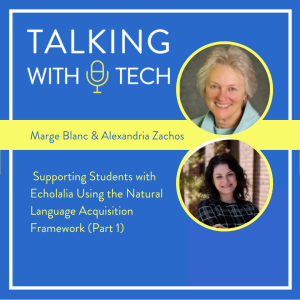
Wednesday Nov 30, 2022
Wednesday Nov 30, 2022
This week, we present Part 1 of Chris and Rachel’s interview with Marge Blanc and Alexandria Zachos. Alexandria and Marge are two SLPs who have written and presented nationally on the Natural Language Acquisition (NLA) framework and Gestalt Language Processing. The NLA framework looks at the different ways that people, especially people with autism, develop language. One important aspect of this is “gestalts”which are strings of language that can be long or short, and are often tied to an emotional, meaningful, or dramatic experience. This episode's half of the interview focuses primarily on "delayed echolalia," which is stage one of the Natural Language Acquisition framework.
Before the interview, Chris shares about a previous experience being taught about “learning styles” in grad school (e.g. visual learner, auditory learner) and how "learning styles" were contradicted by later evidence. Chris discusses ASHA’s triangle of evidence-based practice (e.g. what research says, what clients who got the intervention say, and what experts in that area say about the concept) and how he uses it to engage with new ideas and concepts with a balance of skepticism and openness to new ideas.
Key ideas this week:
🔑 Gestalts involve episodic memory as opposed to semantic memory. A person who is gestalt language processing assigns meaning to a whole chunk of sound - it’s the soundtrack from an experience. For example, a child may pick up the script “To infinity and beyond” watching a movie they really enjoy. Later, when they do another activity they enjoy, they might say “To infinity and beyond!” again.
🔑 According to Marge and Alexandria, we shouldn’t jump stages and start teaching individual words and morphemes to someone in stage one of the NLAF. Because the NLA framework is a developmental process, we wouldn’t want to jump ahead to teaching Step 4 before going to Step 2 and 3. If we do, they may develop splinter skills in some areas without developing important foundational skills and understanding.
🔑 When older children and adults say a shortcut phrase or idiom (e.g. “Autobots roll out” to leave the house), it is probably not a “gestalt”. Gestalts are primarily used by younger children in Stage 1 of the Natural Language Acquisition framework, and are usually tied to emotional, meaningful, or dramatic experiences.
To listen to the previous episode with Alexandria Zachos, go to
https://www.talkingwithtech.org/episodes/alexandria-zachos
Visit talkingwithtech.org to access previous episodes, resources, and CEU credits that you can earn for listening to TWT episodes!
Help us develop new content and keep the podcast going strong! Support our podcast at patreon.com/talkingwithtech!
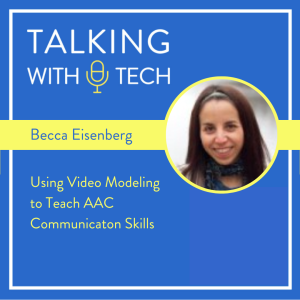
Saturday Nov 26, 2022
Saturday Nov 26, 2022
This week on TWT, Rachel interviews SLP and AAC Specialist Becca Eisenberg about her work with older AAC users, including why she created her own YouTube Channel for video modeling called Life Skills to Learn! Becca shares ideas for motivating AAC users, including giving AAC users the freedom to direct therapy in new, more directions that are more interesting to the AAC user.
Before the interview, Chris and Rachel talk about one of Rachel’s older students who is still frequently using the word “potty” to ask to use the bathroom. The AAC user’s therapist asked Rachel about using more “mature” words, like “bathroom”, and she wondered if they should change the word on the device from “potty” to “bathroom”. Chris shares why he wouldn’t change the word “potty” to “bathroom” or anything else, and strategies we can use instead to encourage an AAC users to use a new word. Rachel shares her ideas for helping the student, including adding a bathroom “quick fire” pre-stored phrase that uses “bathroom”.
Key ideas this week:
Chris wondered about using the Frayer model to teach new words to AAC users. The Frayer Model is typically a graphical organizer divided into four quadrants. In the first quadrant, students list the definition of a word, the second contains examples (or pictures of examples) of the word, the third quadrant contains non-examples of the word, and the fourth contains characteristics of the word.
If we want an AAC user to use a new synonym to ask for something we need to explicitly teach the word we would like them to use and, when talking with the AAC user, we should change to use the same word ourselves.
We can use video modeling of functional tasks, like those on Becca’s YouTube channel Life Skills to Learn (https://www.youtube.com/@Lifeskills2learnwithBecca), to teach language concepts and functional skills at the same time.
We can better facilitate communication for AAC users when we give them choices during therapy and build trust. In Becca’s experience, when AAC users realize they have the freedom to direct where therapy goes next, they often communicate more. Becca sometimes has activities planned that she doesn’t get to on because the student wanted to communicate about something else.
Visit talkingwithtech.org to access previous episodes, resources, and CEU credits that you can earn for listening to TWT episodes!
Help us develop new content and keep the podcast going strong! Support our podcast at patreon.com/talkingwithtech!

Thursday Nov 17, 2022
Thursday Nov 17, 2022
This week, we share Chris’s interview with Dr. Cheri Dodge Chin, an AAC researcher, blogger, and professor who recently has done research into the effectiveness of caregiver AAC training via online video chat. She shares valuable strategies for Her results showed that many caregivers were able to learn modeling strategies for shared reading during online video chat in as little as an hour!
Before the interview, Chris shares with Rachel about his trip to the about the ImpAACt Voices Conference (https://www.impaactvoices.org/)! Chris touches on creating opportunities for adult AAC users to gain employment through community training, the need to evaluate how we can better prepare AAC users for employment, and the value in bringing the community and AAC users together to learn from each other.
Key ideas this week:
🔑 Being a good shared reader and communication partner is something that takes practice; it’s not a talent that people are just born with.
🔑 Some parents need to be taught not to turn reading into an interrogation. We want the AAC user to relax and have fun, not just answer a series of questions.
🔑 Dr. Dodge Chin taught the “WISE” strategy parents to use when modeling AAC, which stands for: Wait five (or more) seconds, Invite (don’t quiz), Show (i.e., model), and Expand.
🔑 Dr. Dodge Chin used the “Read Ask Answer Prompt” strategy for building communication skill during storybook reading by Drs. Cathy Binger and Jennifer Kent Walsh. You can learn more from Carole Zangari here https://praacticalaac.org/praactical/building-communication-skills-during-storybook-reading/
Visit talkingwithtech.org to access previous episodes, resources, and CEU credits that you can earn for listening to TWT episodes!
Help us develop new content and keep the podcast going strong! Support our podcast at patreon.com/talkingwithtech!
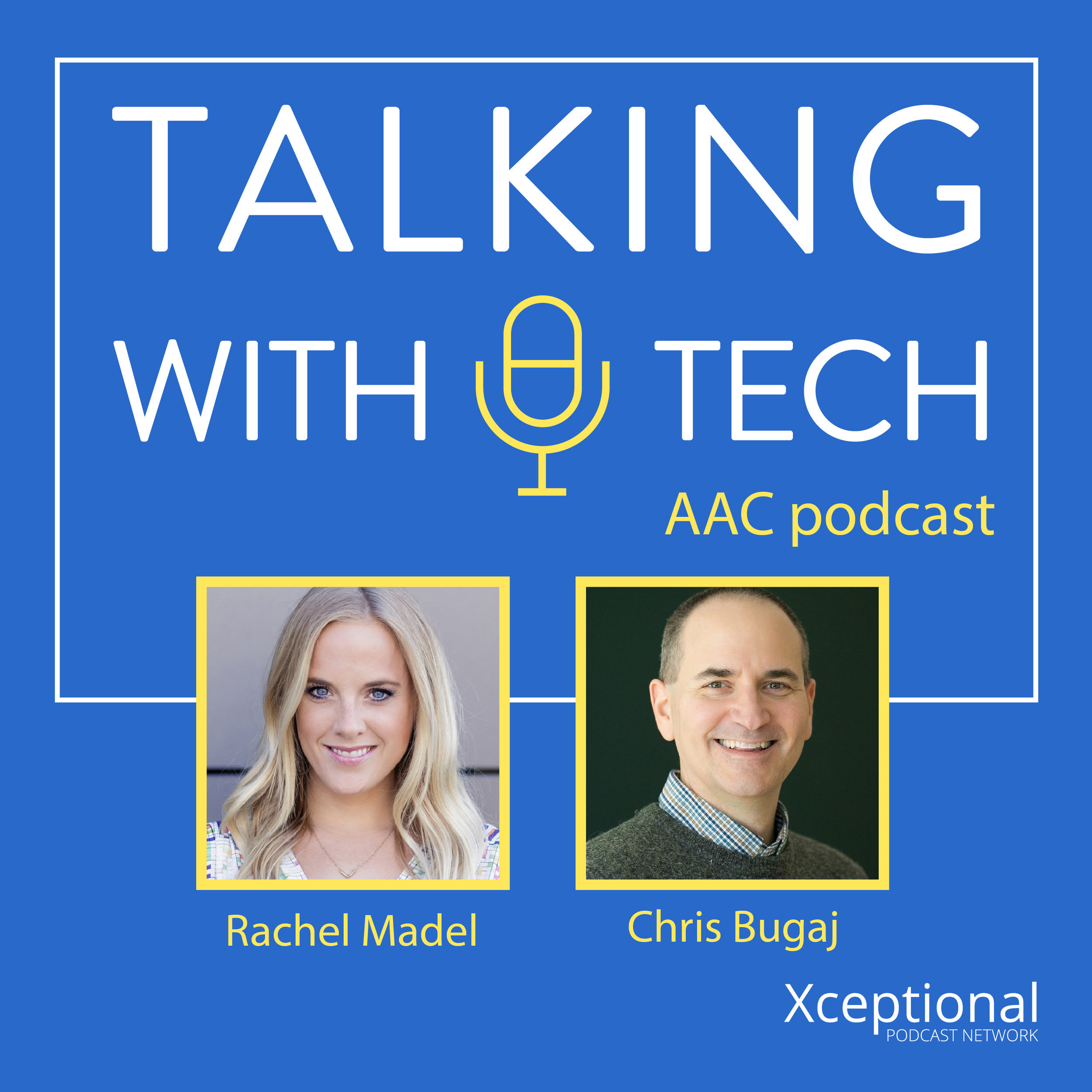
Join AAC experts Rachel Madel and Chris Bugaj as they dive into a weekly discussion about all things AAC (Augmentative and Alternative Communication). Every episode they deliver practical resources, clinical guidelines and relevant research to help clinicians better utilize technology for individuals with complex communication needs.
Episodes include interviews with industry thought-leaders, clinicians, parents, researchers and app developers to keep you on the pulse of the educational technology scene and better support communication through the use of technology.


